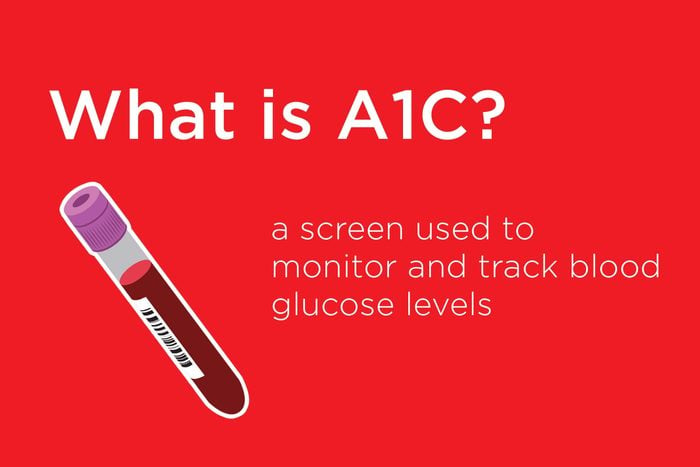
What is a hemoglobin A1C test?
There are many tests for people with diabetes and one of the most important ones is called hemoglobin A1C or A1C. (It’s also known as the HbA1C, glycohemoglobin, or glycated hemoglobin test.) This crucial test has been used to monitor and track people’s blood glucose for more than 40 years.
Health-care providers use this tool to get a three-month window into a person’s blood sugar levels. So it’s not a measure of blood sugar at a single moment in time, but rather a sense of how high your blood sugar has been in recent months.
“It helps us analyze if you are under good, moderate, or poor glucose control, and can thus help us direct comprehensive care recommendations, and work with you in achieving and maintaining good compliance of treatment goals,” says Mona Morstein, a naturopathic doctor and author of Master Your Diabetes: A Comprehensive, Integrative Approach for Both Type 1 and Type 2 Diabetes and founder and executive director of the Low Carb Diabetes Association.
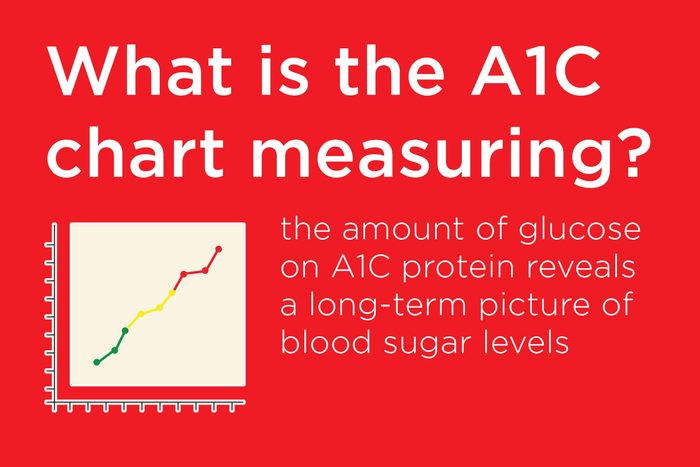
What is the A1C chart measuring?
Hemoglobin is the oxygen-carrying protein found in red blood cells, and A1C is one type of hemoglobin. Blood glucose or blood sugar tends to stick to A1C, explains Dr. Morstein. Once it’s stuck, it stays there for the entire life of a red blood cell.
Because red blood cells have a lifespan of about three to four months, the amount of glucose attached to the A1C protein reveals a long-term picture of blood sugar levels. For example, an A1C of 6.0 simply means about 6 percent of glucose is attached to the red blood cells, and that can give both people and doctors a sense of the average blood sugar level over time, as opposed to pinprick blood sugar tests, which capture levels at one particular moment. (If you’re battling fluctuating levels, here are seven ways to control your blood sugar.)
For reference, a person without diabetes usually has an A1C below 5.7 percent. If your A1C is higher, about 5.7 percent to 6.4 percent, you may have prediabetes, and even higher—anything 6.5 percent or above—suggests you have diabetes.
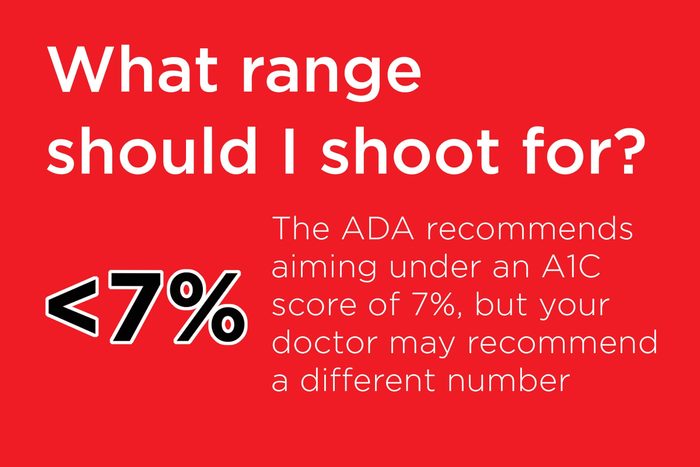
What range should I shoot for?
The American Diabetes Association recommends that most people with diabetes aim for an A1C of less than 7 percent (that translates to a daily average glucose level of 154 milligrams per deciliter of blood). However, your doctor may recommend a different number depending on your age or other factors.
For example, the American Association of Clinical Endocrinologists and the American College of Endocrinology recommend an A1C of 6.5 percent or lower for people with type 2 diabetes who don’t have other serious illnesses and who have a low risk of hypoglycemia (low blood sugar that can be caused by medication). The groups recommend an A1C goal above 6.5 percent for those with additional serious illnesses or who are at higher risk for hypoglycemia.
But that daily average can be deceptive: For example, a person could have an A1C of 6 percent, which translates into an estimated average glucose (eAG) of 126 milligrams per deciliter of blood for the last three months. However, says Dr. Morstein, “the patient could go down to 40 and up to 192 and wind up with an average of 126, showing very bad glucose control.”
“In reality, a person with diabetes should strive to avoid damage to the body, and the development of diabetic complications, by having have the lowest A1C possible, ideally less than 6.0 or even lower,” says Dr. Morstein.
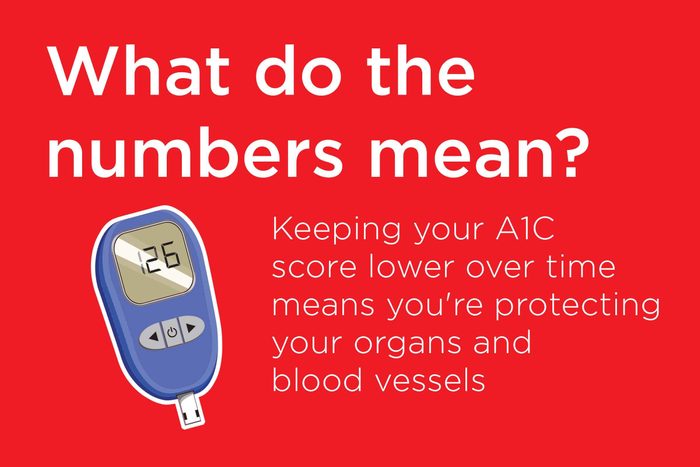
What do the numbers of my A1C mean?
Keeping your A1C score lower over time means you’re protecting your organs and blood vessels from the damage high blood sugar levels can do.
“If a health care provider wanted the individual to strive for an A1C of 6 percent, they would have to advise them to have an average blood sugar reading of 126 (splitting the difference between the two numbers) or a range of 100-152mg/dl says, registered dietitian Joanne Rinker, director of Practice and Content Development, American Association of Diabetes Educators.
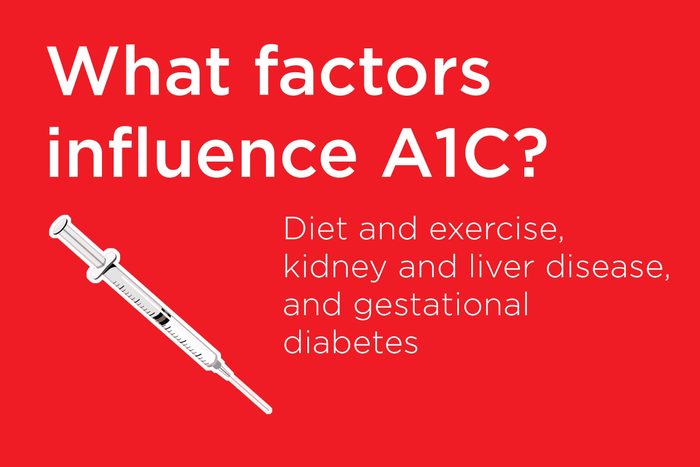
What factors influence A1C?
Along with your diet and exercise habits, conditions that can influence an A1C are kidney and liver disease, and gestational diabetes in pregnant women.
“In the case of gestational diabetes, an A1C test may need to be done more often,” says Rinker. “Anemia and other conditions that affect the red blood cells will cause changes or inaccuracies with the A1C percentage.”
A 2017 study in JAMA revealed African Americans with sickle cell trait had lower A1C values (5.72 percent vs 6.01 percent), compared to those without sickle cell trait.
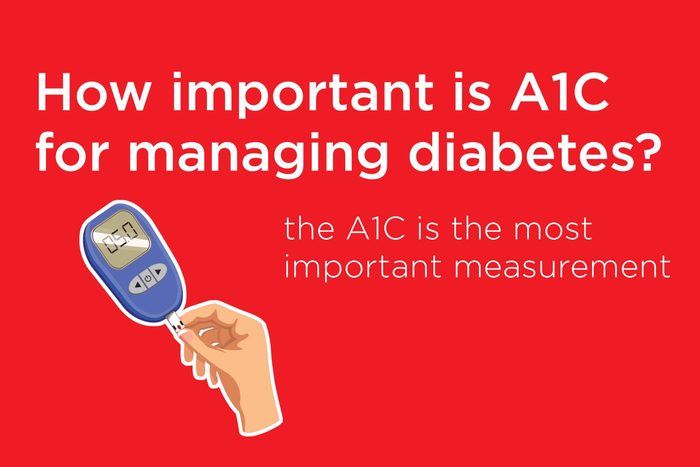
How important is A1C for managing diabetes?
According to Rinker and Dr. Mortstein, the A1C is the most important measurement when working with a person with diabetes, though they’d like to follow patients even more closely if they could. “If we had the ability to check as often as we wanted to, we’d be able to find out so much about the person with diabetes and how their individual body processes blood sugar,” says Rinker. This would entail things like checking blood sugar before meals and two hours after, testing before, during, and after exercise, and even factoring in positive or negative stress.
In the absence of regular blood sugar checks, the A1C provides valuable trends for a certified diabetes educator—the health care professional who helps people with type 2 diabetes manage blood sugar with healthy eating, exercise, and other lifestyle changes.
“We can talk about how we could work together to make some small adjustments to their meal plans—a self-care behavior that can really improve their blood sugar when it is traditionally high, in this example,” says Rinker. (Don’t sabotage your health by falling for these diabetes myths.)
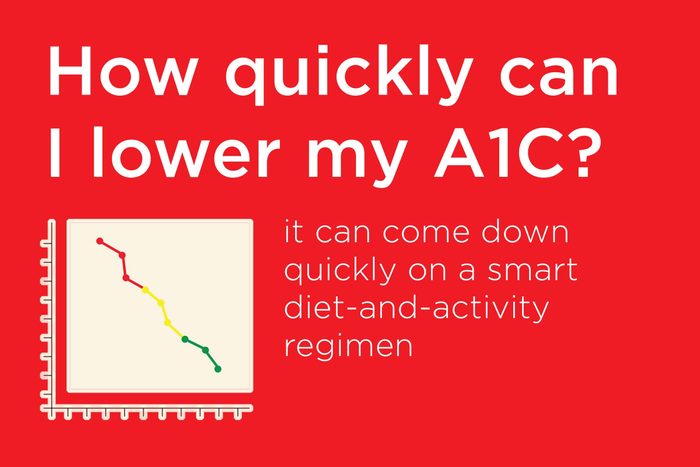
How quickly can I lower my A1C?
A high A1C score may be distressing, but the good news is it can come down quickly on a smart diet-and-activity regimen. “There is no real limit to how much an A1C can lower in three months,” says Dr. Morstein. “A person can start off with an A1C of 12 percent and in three months have an A1C of 6.0 percent.”
For example, if people keep a daily food diary along with a glucose graph that tracks sugar checks throughout the day, within several days they could develop a targeted plan that can dramatically lower A1C.
“It’s unfortunate that, in conventional care, this is so rarely done,” says Dr. Morstein. “But with physicians who do integrative medicine, it is a very common approach.” says Dr. Morstein. Dropping your A1C lowers your risk of diabetes complications so you can live a longer, healthier life.
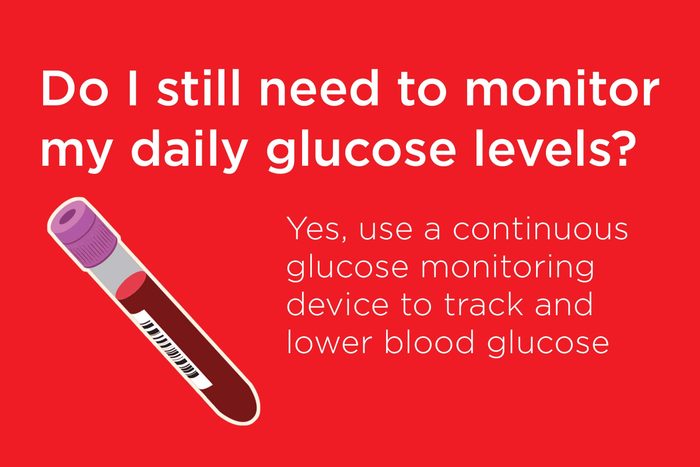
Do I still need to monitor my daily glucose levels?
It depends on what type of diabetes you have, and what your doctor recommends. In some cases, the answer is yes, according to registered dietitian Deborah Malkoff-Cohen, who has a private practice in New York City. The first thing on your to-do list for lowering A1C may be to use a continuous glucose monitoring device to track and lower blood glucose—but again, it depends. These devices usually make more sense for people with type 1 diabetes, who often use an insulin pump and need to check blood glucose multiple times a day to fine-tune their insulin intake.
People with type 2 diabetes—who may or may not take insulin—might be doing finger sticks to check blood sugar once a day, less often, or sometimes not at all, depending on what their doctor recommends. Whether you are checking your blood sugar daily or not, A1C tests can help determine how well you are doing in regards to blood sugar control over time.
To help control blood sugar, Malkoff-Cohen strongly recommends portion control and always eating carbs with a protein.
“Carbs should be the last thing you eat on your plate. Eat protein first,” advises Malkoff-Cohen. Also, talk to your doctor about increasing your activity.
In one study in Atherosclerosis, when inactive people with type 2 diabetes did a combination of aerobic and resistance training three times a week for five weeks, their A1C improved about twice as much as doing either exercise alone. Why? Building muscle mass burns more glucose during exercise and when you’re just relaxing on the sofa. The benefit is decreased insulin resistance.
